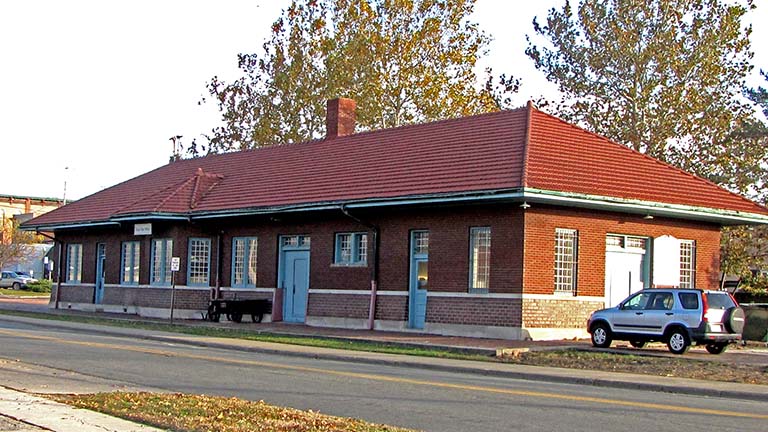

Michigan’s first governor, Stevens Mason, strongly promoted his sparsely populated and remote state. He successfully floated bonds, in 1837, whose revenue would build three east-west rail lines. Only a little work was done on a southern line that was planned to stretch from Monroe to New Buffalo before that railroad was sold to private investors in 1844. Using state funding, the central line was slowly built from Detroit to Kalamazoo over a seven-year span . It was a money losing proposition so the state legislature also sold this line to private investors: a financially secure group from Boston. By 1853, the new owners invested sufficiently such that both the southern and central lines reached Chicago.
Railroads, in the 1850s, generally had great trouble raising capital but technological developments occurred in that decade that made them much safer and more effective in handling freight and passengers. Population growth also helped. However, the lack of capital led railroad owners, in the 1850s, to assume that they would primarily operate major trunk lines between ports or large cities and that much of what they carried would be brought from or delivered to rural areas linked to their lines by wagons.
Railroads prospered greatly in the Civil War. They proved that they could move large numbers of soldiers and tremendous amounts of supplies long distances quite rapidly and at reasonable costs. Investors, after that war, were eager to invest in rail lines. And the leaders of cities—large and small—knew that the future of their location depended crucially upon being connected to an emerging national rail network, preferably by two or more lines so that they would be price competitive. By the end of the 1860s, rather than depending upon wagons to bring goods to their trunk lines, railroad owners started building feeder line or bought short line railroads that linked their trunk line to small towns.
The Michigan legislature granted a charter for a line between Jackson and Grand Rapids in 1846 but the building occurred slowly. The Grand Valley Railroad completed this line in 1870. It passed through Eaton Rapids, Charlotte, Vermontville, Nashville, Hastings, and Middleville on its way west. This line was purchased by the Michigan Central Railroad in the year of its completion. And the Michigan Central became affiliated with the New York Central later in the 1870. In 1926, the Michigan Central was subsumed into the New York Central.
Jackson was a major railroad center for Michigan until after World War II with lines radiating in seven directions. The Michigan Central offered through passenger service from Grand Rapids to Detroit on this line but most passengers traveling between those cities used the more direct route of the Pere Marquette.
With the successful timbering of Michigan white pine forests and the development of the industrial era in the later decades of the Nineteenth Century, small towns such as Hastings and other hamlets along this branch line generated much business for the railroads. Numerous small factories were built to produce products for the national market or components products for larger manufacturers. Most all of what they needed and what they manufactured traveled by rail. The railroads did well. Two lines served Hastings, the Michigan Central and the Chicago, Kalamazoo and Saginaw but that one quit in 1937.
Just as manufacturing kept the railroads prosperous, so too did its demise explain the abandonment of about one-half of the rail mileage in Michigan. The last passenger service train through Hastings—a one-car round trip daily from Jackson to Grand Rapids and return—ended in 1959. Freight service continued to 1983 but business disappeared and, today, there are no rail lines in Hastings. A small stretch of the former Michigan Central line in Hastings has been paved for use as a bicycle trail. The Penn Central railroad sold that substantial brick depot to private interests in 1968. It has been refurbished into attractive offices for lawyers.
Hastings is also home to an historical marker commemorating the Chicago, Kalamazoo and Saginaw Railroad. This was erected near the intersection of Center Street and M-37.
Hastings got its name from the auditor-general of the state of Michigan in the late 1830s. He also served as president of the Bank of Michigan, and in that capacity, he sold a tract of land in Barry County to three promoters from Marshall, Michigan, with the understanding that it would be the county seat. They sought to sell land and establish a town named after Hastings. By 1839, a grist mill was operating here and, the next year, a store opened.
Date of Construction: 1922
Architects: Unknown to me
Architectural style: There are some Italian Renaissance elements.
Use in 2011: Law offices
State of Michigan Registry of Historic Sites: P22,532 Listed July 26, 1974
State of Michigan Historical Marker: Erected: August 7, 1974
National Registry of Historic Places: Not listed
Photograph: Ren Farley; November 5, 2011
Description prepared: November, 2011
Return to Transportation
Return to Homepage